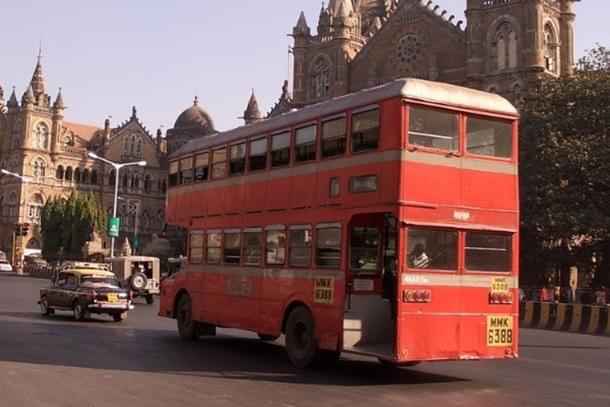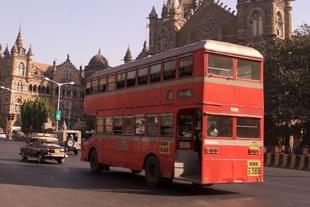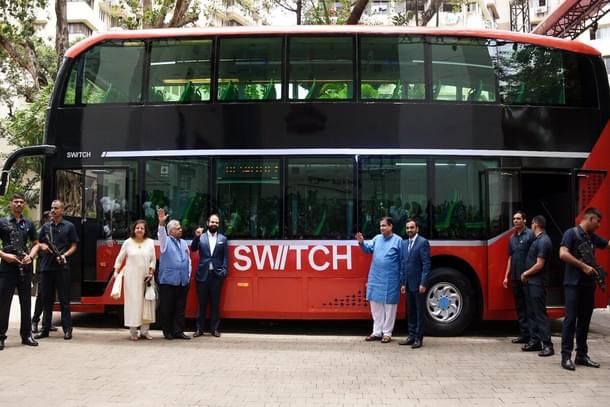Infrastructure
Explained: Mumbai’s Historic Love Affair With Iconic Red Double-Decker Buses And Their Grand Comeback
V Bhagya Subhashini
Aug 23, 2022, 04:59 PM | Updated 06:05 PM IST
Save & read from anywhere!
Bookmark stories for easy access on any device or the Swarajya app.


On Thursday (August 18), Brihanmumbai Electricity Supply and Transport (BEST) unveiled its first double-decker electric bus with a modern twist, reviving Mumbai's 70-year love for the historic red buses.
The buses will begin operating on the roads in four weeks. BEST plans to acquire 900 e-buses and roll them out gradually until 2023.
Mumbai, one of the great cities, has long served as the country's economic and industrial centre.
Yet, three hundred years ago, Mumbai was nothing more than a jumble of tiny islands. At the beginning of the eighteenth century, these 'islands' were eventually joined to form what would become the First City of India.
On July 15, 1926, Mumbai saw its first bus run to ease the traffic situation in the city. For many years, buses were regarded as a mode of transportation for the upper middle class.
Double-decker buses were introduced in 1937 to keep up with the growing traffic. They were based on the motorised double-decker buses of London.
The first Limited Bus service in Mumbai, possibly the first in the country, began running between Colaba and Mahim in 1940.
Significance Of Double-decker Buses In The Past
By the 1960s, 26 bus routes were operating throughout Mumbai. The buses had become one of the city's most distinguishing features. They are more popular with tourists and locals alike, especially those looking for a night out in South Mumbai.
South Mumbai's streets were more serene, less congested, and visually appealing.
The double-decker buses provided passengers with a beautiful view of the city because of their height.
Older city dwellers still cherish the memories of their youth and childhood exploring the city while riding the upper deck of double-decker buses.
As auto-rickshaws didn't arrive in the suburbs until the 1970s, the red buses also functioned as the last mile of connectivity.
One of the busiest routes in the suburbs was from Santacruz station to Juhu Church during the morning and evening hours.
The buses were initially given names based on letters of the English alphabet, but as the city grew and its population swelled, their names were changed to include numbers.
For instance, route 123 ran between the RC Church in Colaba and Tardeo. It passed by the Colaba Causeway, the Regal Cinema, Flora Fountain, Marine Drive, and Girgaum Chowpatty, replacing the city's well-known route 'C'.
Another well-liked route was 130, which went via Fort Market, Crawford Market, and Pydhonie, providing a new perspective on the city and highlighting some of its nightlife.
Reasons for Phasing out of Double-Decker buses by BEST
As Bombay grew over the years, so did the number of these buses. They peaked at 900 in the 1960s. But the number of buses remains at 48, which will be phased out by 2023.
BEST phased out these buses mainly because spare parts were scarce, and they were more expensive to buy. They were also cumbersome to transport, leading to many difficulties.
Double-deckers were also becoming economically unviable because of their high fuel consumption.
It was not until 1955 that an Indian firm, Ashok Leyland, began producing them.
Before that, buses were all produced by foreign companies like Daimler, AEC (Associated Equipment Company), and Leyland Motors because they were all launched during the British administration.
BEST also claimed that operating double-decker buses required more personnel, including an additional conductor for the upper deck.

Features Of New AC Double Decker E-Bus
The New AC Double Decker E-Bus' Switch EiV 22' is powered by a 231-kWh capacity, 2-string, liquid-cooled, higher density NMC chemistry battery pack with a dual gun charging system which gives the electric double-decker a range of up to 250 kilometres for intra-city applications.
Each e-bus can save 1.3 lakh litres of diesel per year in fuel consumption.
The buses will have automatic doors, CCTV cameras, and particular communication arrangements for the two conductors.
These environmentally friendly, air-conditioned vehicles will be wet-leased by BEST. Besides providing drivers, the private operator would also maintain and operate the buses. BEST pays Rs 56.40 per kilometre to the operator, reports Indian Express.
Transportation expert Ashok Datar says the buses will benefit commuters because they can accommodate twice as many on the same road.
Brihanmumbai Electricity Supply and Transport (BEST)
BEST is a public civic transport and electricity provider based in Mumbai, Maharashtra. The organisation was renamed Brihanmumbai Electric Supply & Transport (BEST) in 1995.
It now functions as an autonomous body under the Municipal Corporation of Mumbai.
BEST operates one of India's largest bus fleets. The bus service serves the entire city and outside city limits in neighbouring urban areas. Besides buses, it also operates a ferry service in the city's northern outskirts.
V Bhagya Subhashini is a staff writer at Swarajya. She tracks infrastructure developments.




